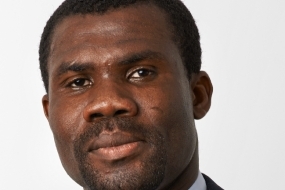Collins Teye - Urban intermodal terminals: The entropy maximising facility location problem

Guest speaker Collins Teye a PhD candidate from the Institute of Transport and Logistics (ITLS), University of Sydney Business School presented a seminar at rCITI on Thursday 14 April 2016.
Collins is Chartered Mathematician (CMath), Chartered Scientist (CSci) and Chartered member of the Chartered Institute of Logistics and Transport (CMILT) with several years transport modelling experience and is an experienced project manager. He is also a member of the European Mathematical Society (EMS). Prior to joining ITLS as PhD student, he worked as Consultant in the UK and has managed or played a leading role on several projects including the recent updating of the Scottish National Model (TMfS12), Scottish Long Distance Model, Integrated Master Plan for Cross River State, Nigeria, Cheshire Sub-Regional Strategic Model (CSRSTM), UK, Ashford Area Transport Model (AATM), UK, Islington Asset Management System & Transport Model, UK, Kurdistan Matrix Building, The PRISM Review Project, UK, and Amman Ring Road Study. Collins has also managed a number of Public Private Partnership (PPP) projects in Africa including Port Harcourt ring road feasibility study, Guto-Bagana toll bridge study, Shagamu-Benin-Asaba toll road, Onitsha-Enugu toll road, and toll bridge feasibility study on River Niger. His current research at ITLS is on developing a modelling capability in support of policy on the siting and design of inter-modal container terminals in metropolitan areas under the supervision of Professors Mike Bell and Michiel Bliemer.
His topic was on an important problem confronting port cities is where and how to accommodate port growth. Larger ships offloading larger batches of containers require more yard space and generate bigger traffic peaks, straining the urban fabric in the vicinity of the port. A promising solution to this problem is the development of urban intermodal container terminals (IMTs) that interface with both road and rail (or possibly inland waterway) networks. This raises two linked choices; where to locate the intermodal terminals and what will be their likely usage by multiple shippers, each having a choice of whether or not to use the IMT as part of an intermodal transport chain. The IMTs are expected to also perform auxiliary activities such as warehousing and empty container storage such that these activities can be relocated to them to provide extra revenue. The overall problem therefore consists of a mode choice and distribution problem embedded within a facility location problem. This study proposes an entropy maximising approach to combine a logit mode choice and distribution model with a facility location model, leading to a non-linear mixed integer programming model. The principal features of the entropy maximising facility location model are illustrated by small and large numerical examples.




